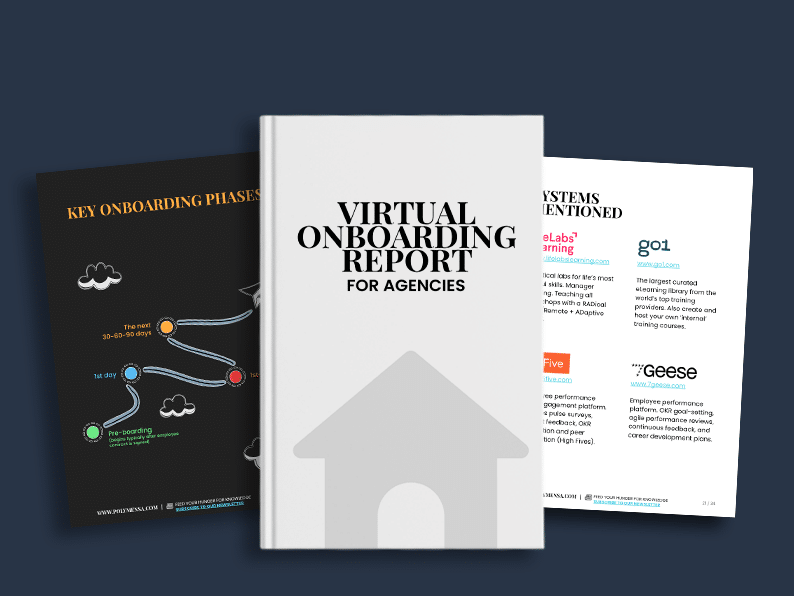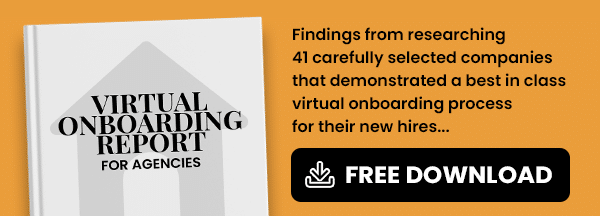
Remote working mental well-being tips
January 19, 2021
Different team structures in agencies
February 23, 2021Remote working and virtual onboarding at agencies
In 2020 our sector was forced to shift to a remote working model. For most agencies hiring new starters in a virtual environment was a first. Virtual onboarding was a first.
At Polymensa we are always curious to understand a topic in-depth. In this particular case we wanted to understand how progressive companies and agencies are bringing new hires on board.
An extensive research was performed. 41 qualitative interviews with progressive SAAS businesses and agencies. Those that demonstrated the best virtual onboarding experiences, validated by exceptional feedback from their new starters.
The goal is to help agencies navigate these new onboarding challenges. To ensure your new starters are fully immersed in your culture, despite working from home and are as productive as quick as possible.
Key phases of virtual onboarding
Most of the agencies researched had similar phases of onboarding, with minor variations. These key four phases are:
1. Pre-boarding (begins typically after employee contract is signed)
2. 1st day
3. 1st-2nd week
4. The next 30-60-90 days
Pre-boarding
This phase existed in all but one business we spoke to. Companies reported a significant reduction in employees leaving during the probation period, after implementing a well-planned pre-boarding process.
Those that had an exceptional pre-boarding also had rigorous checklists of what needs to be done to ensure the starter has everything they need. This checklist either lived in a system or a simple spreadsheet. The Virtual Onboarding Report contains a list of all the systems that were used to manage onboarding tasks.
Org-charts
Planning your new virtual onboarding process can take a significant amount of time. But you might already have candidates who are about to sign their employment contracts. In those cases there are a couple of simple to implement processes that were well received by new hires across all the companies we researched.
Send out org-charts with profile pictures of every single employee in the company to your new hire. This will help them with context of the people they see on Slack or Teams on their first day. Or people they see in their first video calls where there are too many people to introduce each individually in the call.
Meeting the founders, CEO and other directors
Being able to meet the company execs and founders made new starters feel cared for - especially in the current climate of remote working. Ideally this was done in a 1-to-1.
This was harder for the larger organisations 150+ staff who ended up doing group Q&As with board execs. Or recorded personalised welcome messages.
Measuring the success of your virtual onboarding process
The most progressive agencies put a lot of effort into measuring three things:
Employee progression
Most agencies had 30/60/90 day surveys to check whether the new employee is performing to their expectations.
Line manager performance
Some of the agencies interviewed surveyed new hires, whether their line manager is helping them progress and providing enough support. For companies that had People Ops Directors, they would check in with line managers if the survey responses were negative.
Employee satisfaction
Some companies had a survey that would check whether the company was meeting their expectations. For negative responses, one company usually so a churn of that new hire within 9 months.
Mental well-being tips for new hires
Starting a new job is scary even in an office environment - let alone when you're at home. If there isn't constant contact with the new hire, they may feel overly anxious about their role.
"Does the team like me?"
"Am I doing enough work?"
"Have I made the right decision of taking this job?"
We put together an additional article that gives you practical tools for you and your employees to feel less anxious about working from home. Read the full article here.
34 pages of practical tips to improve your virtual onboarding
The full report contains plenty more great tips for your agency. If you have any questions, we're always happy to help out. Feel free to get in touch with daniel@polymensa.com





